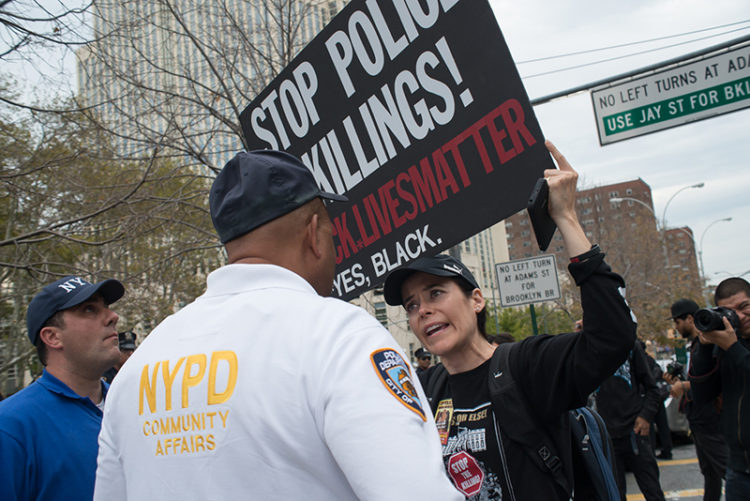Measuring The Problem

I am blessed with having some wonderful nerds in my life. They love numbers and working with numbers to help them understand and explain the world.
[It is the second week of July 2020. Last week (see “Black Power & Little Micah“) I started writing about race and current events with the goal of encouraging thought and out-of-the-echo-chambers conversation. I won’t get everything right or say everything right, but I hope at the end, we all will have a better perspective of what is both true and good. Our society depends on people who disagree being able to discuss ideas and perspectives with humility, respect, and a desire for the truth. This is my small contribution to a better future through conversation.]
One of my nerd friends is a finance guy. When figuring out reality, he takes a passionate stance against anecdotes versus reproducible data. Anecdotes are stories of single incidents and reproducible data is – well, reproducible data; it is a measurement of numerous data points that can be consistently repeated with the similar outcomes. Both of these things are methods modern human beings use to understand their world. Both anecdotes and data can give us a misleading impression of a situation, but anecdotes, explanative stories of single or a handful of instances, far more easily lead us to the wrong conclusions. Unfortunately, we human beings are far more likely to believe an anecdote than we are to believe reproducible data.
Let me give an example.
When you were a kid, you probably went trick-or-treating on Halloween and probably your parents made sure you didn’t get any candy that looked like it could have been opened. The reason for this? It is because back in the 1970s a series of stories began to be discussed on the news and among government officials about the possibility of strangers putting poison or razor blades in children’s candy. Societal fear went through the roof. Frightening stories and preventative measures became the talk around every Halloween for decades. Both behaviors and laws were changed in light of this terrifying threat.
Then, in 1984, a comprehensive study was done on this threat. What did the number crunchers discover about this terrifying threat that every responsible American parent took seriously? Not a single incident of a child’s death or serious injury from being poisoned by a Halloween stranger was discovered. Not one. All the hype, fear, drama, news coverage, changed behavior, and changed law was all over something that never happened. And today, nearly four decades after the number crunchers disproved the myth, the fear of stranger-poisoned candy still effects Halloween today.
That is the power of an anecdote, especially a fearful anecdote, compared to the power of reproducible data.
Today, in the world of 24/7 media and video cameras everywhere, the power of anecdotes has never been greater. We can watch with our own eyes, even when what we are watching is sometimes misleading.
What if a video emerged showing an Asian woman snatching a Hispanic kid in a park and running off? What if there were a handful of these videos of a number of similar incidences over a few years from across the country? What if the news media talked it up, played them over and over again, downplayed any context, and regularly broadcast emotional interviews and speeches that engendered empathy, fear, and outrage?
What we all know would happen is that a significant number of human beings in our country would be terrified of Asian-woman-baby-snatchers. After all, we’ve all seen it with our own eyes. We KNOW! If we’ve watched the same video twenty times, our brain believes we have personally witnessed with our own eyes this situation happen twenty times! And just like the Halloween candy incident, our emotions of fear, empathy, and outrage become the filter through which we accept or reject any new information.
Anecdotes can be beautiful things, but they are incredibly powerful and we are all profoundly open to manipulation by them.
Another nerd friend of mine is a sociologist that does really fascinating and good work. One of my favorite things that she has worked on was when she was called in to investigate a situation where a school board was accused of paying their male principals more than their female principals. There was a lot of anger and hostility over this issue, but was it a real problem and if so, how big of a problem was it?
My friend gathered all the data she could on principal compensation – degrees, years worked, type of school, etc. She took the framework for her research to the board and principals to see if they could think of any other factors. They added some – performance reviews, extra roles taken on, etc.
In the end, through a transparent and thorough measuring process, my friend helped the school board discover that there really was a discrepancy in compensation when it came to principals and their gender. What was the difference? When all factors were taken into account, male principals were paid 2% more than female principals. Was it a problem? Yes. Is it a case of outrageous sexism? I don’t think so. The school board acknowledged the problem and made the financial adjustments necessary to correct the problem and peace returned to the school district. Well done my friend!
These wonderful number crunching friends in my life have encouraged me to “measure the problem” whenever possible. It gives perspective, accuracy, and shields us a bit from the “poison candy” manipulations that we are all susceptible to.
So, what does this approach have to tell us about one of the most visible concerns of our day – the concern that racist police are regularly murdering black people for no other reason than the color of their skin? The empathy, anger, fear, and outrage are high for sure. LeBron James Tweeted, “We’re literally hunted EVERYDAY/EVERYTIME we step foot outside the comfort of our homes.” George Floyd’s family attorney, Ben Crump wrote a book entitled, “Open Season: Legalized Genocide of Colored People.” One of my friends asked a group of people marching off to a protest, “How can I pray for you?” One of the black protestors quickly responded, “Pray that I live to see another day.” That is a tragic and terrifying level of feeling that I think a lot of people can relate to right now. But what does the data say?
Below I have broken down this contemporary concern into a series of questions and the best answers I could find. Like my sociologist friend, my goal here is to find the measured truth. Once we have the problem measured, then we’ll be in a better place to know how to think about it and what to do about it. If you have a reliable and relevant source of data that I did not include, please let me know. The goal is the truth.
1. How many people do the police kill each year? – Around 1,000
According to the Washington Post database, this number has consistently been around 1,000 people every year since 2015. Note: This database does not include killings by other means than shooting. Also, it is important to note, that since there is no national database on police shootings or killings, the Washington Post’s database, while well-researched, and probably the best source of information available, likely does not include a few instances.)
2. How many black people do the police shoot and kill each year? – On average, 239
According to the Washington Post database, the average number of black people killed by police in the years 2015, 2016, 2017, 2018, and 2019 is 239.
3. How many unarmed black people do the police shoot and kill each year? – On average, 23.
According to the Washington Post database, the average number of unarmed black people killed by police in the years 2015, 2016, 2017, 2018, and 2019 is 23. In 2019, fourteen unarmed black people were killed. Every one of these is a tragedy, but for perspective, The National Weather Service, estimates that 27 Americans per year are killed by lightening.
4. How many unarmed black people did the police kill last year who were not fighting the police? –Estimate, 3.
This is a tough question to answer and a contentious one. I think it is an important one though from a survival standpoint. If a physical altercation with the police increases your chance of being killed, than it is probably unadvisable from a survival standpoint. If physically fighting the police increases your survivability or makes no difference, than that would also inform best practices. We know that the police killed fourteen unarmed black people in 2019, but it is hard to find all of the information on each one of the killings to know if they fought the police. There is an incomplete write up on this on Medium.com. All I can do is guess based on what I’ve read about how many of the fourteen unarmed black people who were killed by police last year were not fighting the police. My best guess based on the information I have is three people.
5. On a total basis, are more black people killed by police than white people? – No.
In 2019, 403 white people were shot and killed by the police while 250 black people were killed by the police.
6. As a percentage of the population, are black people killed by police more often than white people? – Yes, more than twice as often.
Black people are 13% of the US population but represent 36% of those shot and killed by police since 2015 (Washington Post). Said another way, based on a race-based percentage of the population, blacks are “killed by police at more than twice the rate of white Americans” (Washington Post).
7. On a behavioral basis, are black people killed by police more often than white people? – No.
While I have written extensively that people are not color-coded and that every person should be treated as a unique individual and a child of God, it is a statistical reality that different groups of people behave differently. For example, the difference between the number of men shot and killed by police officers compared to the number of women is absolutely staggering. I have not seen any group or even individual showing even the slightest concern for this disparity in treatment. Why? It is overwhelmingly accepted that men and women behave differently, especially when it comes to violence and aggression, and so no one is surprised when they see that disparity in behavior reflected in a disparity of outcomes when it comes to interactions with police. Though not as significant as gender, there are also differences in behavior between racial groups. You can read about disparities in criminal activity between racial groups HERE, but just for example, black Americans commit murder at a rate nearly eight times that of white Americans. HERE is an FBI chart on arrests (not convictions!), crimes, and racial groups. THIS report from the NYPD has smart graphs! Another one from Minneapolis PD – with less appealing graphs.
Group behavior, specifically the difference in the murder rate between white and black Americans, suggests that the rate that police kill black people compared to white people is actually low.
A black American named Leonydus Johnson pointed out on Twitter that, “For every 10,000 black people arrested for violent crime, 3 are killed. For every 10,000 white people arrested for violent crime, 4 are killed.” His sources are included in his post.
8. Are black communities disproportionately targeted by police? – Probably not.
In a 2015 survey, nearly four times the number of black people told the Gallup organization that they wanted more policing than the number of blacks who said they wanted less policing. This makes sense in black communities where according to the CDC the leading cause of death among black males from 1-44 years old is homicide – about seven times that of white males in similar age groups.
9. What percentage of interactions with police turn deadly for Americans? – 0.0033-0.002%.
Out of the 30-50 million interactions that the police had with the American public last year, approximately 1,000 were killed – or 0.0033-0.002%. Of the 10 million people arrested, less than 0.01% percent were shot and killed by the police (Source).
10. On a population basis, what are the odds of an unarmed black person being killed by the police each year? – 0.00003%
In 2019, there were 43,984,096 black people in the Unites States (Census). 14 unarmed black people were shot and killed by the police. This indicates that in 2019 the chance of an unarmed black person being killed by the police would have been somewhere around 0.00003%.
11. On a population basis, what are the odds of an unarmed black person being killed by the police while not resisting arrest? – 0.0000068%.
With the same numbers mentioned above, the chance of an unarmed black person being killed by the police in 2019 while not resisting arrest would be 0.0000068%.
12. Are police racist against black people? – Some, undoubtedly yes. Overall, no.
Police officers are people, so undoubtedly you will find among them every failing common to human beings. But, despite black people killing police officers at a rate far beyond what their size of the population might suggest, on the national level, STUDY after STUDY after STUDY after STUDY after STUDY after STUDY after STUDY after STUDY from some of the most prestigious institutions in our country conclude that there is no racial bias against black people when it comes to officer-involved shootings.
So what do you think? Did anything surprise you? It did for me. Did you learn something? I sure did. Did I get everything right? Probably not, but I’ll keep on learning and asking questions. I’ll continue to try to measure the problem – whatever the problems might be.
What do we do with this? I’m not sure, but I hope it can be helpful to those living in terror of being murdered by a racist cop, helpful to those who might say or feel, “Pray that I live to see another day.”
Maybe like the work my sociologist friend does, working towards measuring this problem can help us define it, so we can better understand it.
Until next time.
You might also want to read:



No Comment